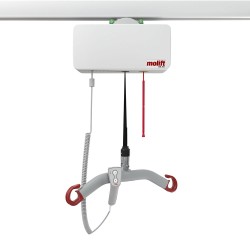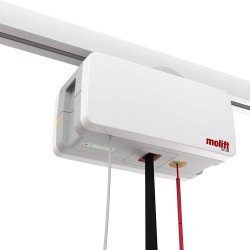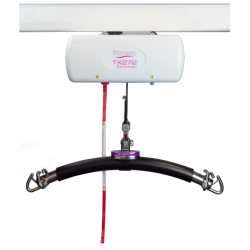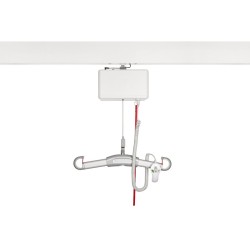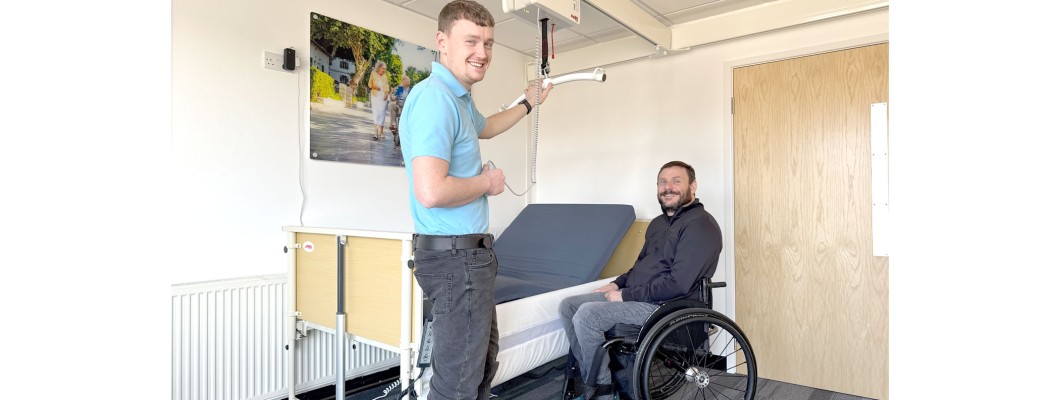
For people with mobility impairments, even the simplest daily tasks can become monumental challenges. Moving from bed to wheelchair, transferring to the bathroom, or navigating tight spaces can be physically demanding, painful, and emotionally draining. Assistive technologies play a crucial role in enhancing independence and quality of life; among these, ceiling track systems stand out as a revolutionary solution. This comprehensive blog post will delve into the profound benefits of ceiling track systems for disabled individuals, exploring how these systems can transform lives and offering a detailed comparison between straight rail and XY systems.
Understanding the Challenge: Mobility Limitations and Daily Life
Mobility limitations can arise from various conditions, including spinal cord injuries, cerebral palsy, multiple sclerosis, muscular dystrophy, and stroke. These conditions often lead to reduced muscle strength, impaired coordination, and difficulty with weight-bearing. Consequently, individuals may require assistance for transfers, repositioning, and mobility within their homes. Traditional methods, such as manual lifting by caregivers, can be physically demanding for both the person being lifted and the caregiver, increasing the risk of injury.
Ceiling Track Systems: A Paradigm Shift in Assistive Technology
Ceiling track systems offer a safe, efficient, and dignified solution for transferring and moving individuals with mobility impairments. These systems consist of a permanently installed track on the ceiling, a motorized or manual hoist, and a sling that supports the individual. The hoist travels along the track, allowing for smooth and controlled transfers between different locations within a room or throughout the home.
Key Benefits of Ceiling Track Systems:
- Enhanced Safety and Reduced Risk of Injury:
- Ceiling track systems significantly reduce the risk of falls and injuries during transfers. The stable and controlled movement provided by the hoist minimizes the physical strain on both the individual and the caregiver.
- Manual lifting, often associated with caregiver back injuries, is eliminated, promoting a safer environment for everyone involved.
- Increased Independence and Dignity:
- Ceiling track systems empower individuals with mobility impairments to participate more actively in their daily routines. They can move between bed, wheelchair, bathroom, and other areas, reducing reliance on caregivers and fostering a sense of autonomy.
- The discreet and dignified nature of ceiling track systems helps preserve the individual's privacy and self-esteem.
- Improved Comfort and Reduced Pain:
- The hoist's smooth and controlled movement minimizes discomfort and pain during transfers. As a result, individuals can be repositioned and moved with greater ease and comfort, enhancing their overall well-being.
- For individuals with chronic pain conditions, ceiling track systems can significantly reduce pain associated with manual handling.
- Enhanced Caregiver Efficiency and Reduced Strain:
- Caregivers experience a significant reduction in physical strain and the risk of injury when using ceiling track systems. The system handles the heavy lifting, allowing caregivers to focus on providing personalized care and support.
- This enhanced efficiency allows caregivers to provide more comprehensive and attentive care, improving the overall quality of life for the individual.
- Optimized Space Utilization and Accessibility:
- Ceiling track systems minimize the need for bulky and cumbersome floor-based lifting equipment, freeing up valuable floor space and improving accessibility within the home.
- The track can be customized to fit the specific layout of the home, ensuring seamless integration and maximizing mobility.
- Improved Mental and Emotional Well-Being:
- Increased independence, reduced pain, and enhanced dignity contribute to improved mental and emotional well-being. Individuals experience a greater sense of control over their lives, leading to increased confidence and self-esteem.
- Reducing the reliance on others also reduces the mental burden that is placed on both the patient and the caregiver.
- Long-Term Cost-Effectiveness:
- While the initial investment in a ceiling track system may seem substantial, it can be a cost-effective solution in the long term. Reduced caregiver strain can lead to fewer injuries and less time off work.
- Reducing the need for multiple caregivers or the need for expensive residential care also reduces long-term costs.
- Customization and Adaptability:
- Ceiling track systems can be customized to meet the specific needs of individuals with varying levels of mobility impairment.
- Different sling types, hoist capacities, and track configurations can be selected to ensure optimal comfort and functionality.
- Systems can be installed in a variety of home environments, including bedrooms, bathrooms, living rooms, and hallways.
Book a Free Ceiling Track Survey by Clicking here...
Straight Rail vs. XY Systems: Choosing the Right Solution
Ceiling track systems can be broadly categorized into two main types: straight rail systems and XY systems. Understanding the differences between these systems is crucial for selecting the right solution for individual needs.
Straight Rail Systems:
- Description: Straight rail systems consist of a single track that runs in a straight line, typically along the length of a room.
- Applications: Ideal for linear transfers, such as moving from bed to wheelchair or from one end of a room to the other.
- Advantages:
- Simple and easy to install.
- Cost-effective compared to XY systems.
- Suitable for straightforward transfers.
- Disadvantages:
- Limited mobility and range of movement.
- May require multiple tracks for complete coverage of a room.
- It cannot cover a large area without multiple tracks.
XY Systems:
- Description: XY systems consist of two or more intersecting tracks that form a grid pattern on the ceiling.
- Applications: Ideal for providing comprehensive coverage of a room, allowing for transfers to any location within the space.
- Advantages:
- Maximum mobility and range of movement.
- Provides complete coverage of a room.
- Enables transfers in any direction.
- Disadvantages:
- More complex and expensive to install.
- May require more ceiling space.
- Requires more planning for optimal usage.
Key Differences Summarized:
| Feature | Straight Rail System | XY System |
|---|---|---|
| Track Configuration | Single straight track | Intersecting tracks forming a grid |
| Mobility | Linear movement | Multi-directional movement |
| Coverage | Limited, linear coverage | Comprehensive room coverage |
| Installation Complexity | Simple | Complex |
| Cost | Lower | Higher |
| Ideal Use | Straight line transfers | Full room coverage and transfers in all directions. |
Choosing the Right System:
The choice between a straight rail and an XY system depends on several factors, including:
- Individual needs and mobility requirements: Individuals who primarily require linear transfers may benefit from a straight rail system, while those who need comprehensive room coverage may require an XY system.
- Room layout and dimensions: The size and shape of the room will influence the type of system that can be installed.
- Budget: XY systems are generally more expensive than straight rail systems.
- Future needs: Consider potential changes in mobility needs and choose a system that can accommodate future requirements.
- FREE Ceiling Track Survey: We offer a free survey to guide you, as we understand it can be a difficult decision.
Installation and Maintenance:
Ceiling track systems must be installed by a certified professional. Regular maintenance, including LOLER inspections and lubrication, is essential in keeping the system in optimal condition and compliant. Families caring for their family members are recommended to have annual service; however, if you're using an external care provider, you will be required to have an annual service and a 6-month inspection, along with a LOLER certificate. You can book our ceiling track service here...
Conclusion:
Ceiling track systems are a transformative assistive technology that significantly enhances the lives of individuals with mobility impairments. By providing safe, efficient, and dignified transfers, these systems promote independence, reduce pain, and improve overall well-being. The choice between straight rail and XY systems depends on individual needs and circumstances. Consulting with a healthcare professional and a qualified installer is essential to select the right system and ensure proper installation. With careful planning and implementation, ceiling track systems can empower individuals with mobility impairments to live more fulfilling and independent lives.

